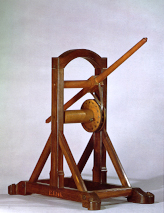
60 x 48.6 x 26.3
Carved wood
INDEX 1788 : E.I.148
Machina ad usum potentiae moventis instructa duplici vecte, duplicique pessulo, et tympano dentato. Desumpta fuit ab ea Machina quam invenit Mr. de la Garouste, proprio quodam nomine Levier a Roue denteé appellatam.
Machine for the use of motive force, equipped with a double lever, a double bolt and a toothed drum. It was taken from the machine invented by M. de la Garouste, called "levier a roue denteé".
This mechanism is an example of a machine which can be used for lifting objects requiring great motive force.
The machine consists of two parallel discs, each surrounded by a metal band. These discs are fixed onto a horizontal cylinder which revolves around its axis and acts as a reel. A rope, used for exerting motive force on the object, is rolled around this cylinder, and one end of it is attached to the reel by a ring.
Small cylindrical iron pins on the edge of the discs keep them joined and strengthen the assembly. Two iron claws are fixed by small linking axles to a two-handled gear lever, and these claws, acting alternately, cause the discs to rotate. As the lever arms move up and down, one of the claws contacts a pin, causing the disc assembly and the reel with the rope to rotate together; meanwhile the other claw contacts a further pin, and the rotation is continued. The pins are thus constantly being gripped by one or other of the claws, thereby ensuring that the reel keeps the traction rope taut.
From Colégio dos Nobres, catalogue n.º 139.
Musschenbroek, Peter van, Introductio ad Philosophiam Naturalem, Leiden, 1762, Vol. I, Vol. X, Fig. 1.